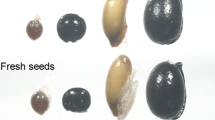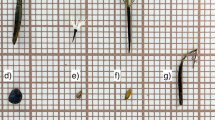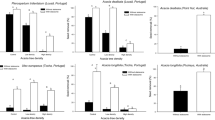Abstract
Viola is one of the diplochorous plant genera that disperse their seeds in two ways, ballistic and ant dispersal. We compared the seed dispersal of two major Viola species of northern Japan, V. selkirkii and V. verecunda. The mean weight of seed was less in V. verecunda (0.42 ± SD 0.03 mg) than in V. selkirkii (0.61 ± 0.12 mg). The elaiosome of V. selkirkii (0.02 ± 0.004 mg) was larger than in of V. verecunda (0.006 ± 0.0004 mg), whereas the lipid component of elaiosome was not remarkably different between the two species. In ballistic dispersal, the mean dispersal distance was 56.0 ± 17.5 cm in V. verecunda but only 38.3 ± 5.1 cm in V. selkirkii. In ant dispersal, the mean dispersal distance was 28.1 ± 24.9 cm in V. selkirkii and 36.1 ± 33.7 cm in V. verecunda; however, the seed removal frequency of V. selkirkii (15.5%) was much higher than that of V. verecunda (3.0%). These results suggest that V. selkirkii is more dependent on ant dispersal while V. verecunda is more dependent on ballistic dispersal. The effect of seed predation was very serious in both species. In the quadrat census, 99.0% of V. selkirkii seeds and 99.1% of V. verecunda seeds were damaged by ground beetles, spiders, ticks, and others which frequently devoured diaspores. An experiment with V. verecunda seeds demonstrated that the overdispersion of seeds on the forest floor enhanced the frequency of removal by ants and reduced seed damage by predators.
Similar content being viewed by others
References
Beattic AJ (1985) The evolutionary ecology of ant-plant mutualisms. Cambridge University Press, Cambridge
Beattie AJ, Lyons N (1975) Seed dispersal in Viola (Violaceae): adaptations and strategies. Am J Bot 62: 714–722
Beattie AJ, Culver DC, Pudlo RJ (1979) Interactions between ants and the diaspores of some common spring flowering herbs in West Virginia. Castanea 44: 177–186
Berg RY (1975) Myrmecochorous plants in Australia and their dispersal by ants. Aust J Bot 62: 714–722
Brew CR, O'Dowd DJ, Rae ID (1989) Seed dispersal by ants: behaviour-releasing compounds in elaiosomes. Oecologia 80: 490–497
Culver DC, Beattie AJ (1978) Myrmecochory in Viola: Dynamics of seed-ant interactions in some West Virginia species. J Ecol 66: 53–72
Culver DC, Beattie AJ (1980) The fate of Viola seeds dispersed by ants. Am J Bot 67: 710–714
Gunther RW, Lanza J (1989) Variation in attractiveness of Trillium diaspores to a seed-dispersing ant. Am Midl Nat 122: 321–328
Hashimoto T (1967) The violets of Japan. Ogawa S, Seibundoshinko-sha, 277 pp.
Heithaus ER (1981) Seed predation by rodents on three ant-dispersed plants. Ecology 67: 136–145
Higashi S, Ito F (1991) Ground beetles and seed dispersal of the myrmecochorous plant Trillium tschonoskii (Trilliaceae). In: Huxley CR, Cutler DF (eds) Ant-plant interactions. Oxford University Press, pp 486–492
Higashi S, Tsuyuzaki S, Ohara M, Ito F (1989) Adaptive advantages on ant-dispersed seeds in the myrmecochorous plant Trillium tschonoskii (Liliaceae). Oikos 54: 389–394
Hughes L, Westoby M (1992) Effects of diaspore characteristics on removal of seeds adapted for dispersal by ants. Ecology 73: 1300–1312
Ito F, Higashi S (1990) Effects of red wood ants on weevil community inhabiting oak trees. J Appl Entomol 110: 483–488
Ito F, Higashi S (1991) An indirect mutualism between oaks and wood ants via aphids. J Anim Ecol 60: 463–470
Marshall DL, Beattie AJ, Bollenbacher WE (1979) Evidence for diglycerides as attractants in an ant-seed interaction. J Chem Ecol 5: 335–344
Masuda M, Yahara T (1992) Dispersal of chasmogamous and cleistogamous seeds in Viola hondoensis W. Backer et H. Boiss. Bot Mag Tokyo 105: 323–326
Milewski AV, Bond WJ (1982) Convergence of myrmecochory in Mediterranean Australia and South Africa. In: Buckley RC (ed) Ant-plant interactions in Australia. Dr. W. Junk The Hague, pp 89–98
Nakanishi H (1988) Myrmecochores in warm-temperate zone of Japan. Jpn J Ecol 38: 169–176
Nijima K (1971) Seasonal changes in collembolan populations in a warm temperate forest Japan. Pedobiologia 11: 11–26
Nijima K (1971) Seasonal changes in collembolan populations in a warm temperate forest Japan. Pedobiologia 11: 11–26
Nijima K (1975) Seasonal changes in collembolan populations in a warm temperate forest of Japan II. Population dynamics of the dominant species. Pedobiologia 15: 40–52
O'Dowd DJ, Hay ME (1980) Mutualism between harvester ants and a desert ephemeral: seed escape from rodents. Ecology 61: 531–540
Ohara M, Higashi S (1987) Interference by ground beetles with the dispersal by ants of seeds of Trillium species (Liliaceae) J Ecol 75: 1091–1098
Price MV (1978) Seed dispersion preference of coexisting desert rodent species. J. Mammal 59: 624–626
Skidomore BA, Heithaus ER (1988) Lipid cues for seed-carrying by ants in Hepatica americana. J Chem Ecol 14: 2185–2195
Sullivan TP (1978) Lack of caching of direct-seeded Douglas fir seeds by deer mice. Can J Zool 56: 1214–1216
Tamura H, Nakamura Y, Yamauchi K, Fujikawa T (1969) An ecological survey of soil fauna in Hidaka-Monbetsu, Southern Hokkaido, J Fac Sci Hokkaido Univ Ser VI Zool 17: 17–57
Turnbull CL, Culver DC (1983) The timing of seed dispersal in Viola nuttalli: attraction of dispersers and avoidance of predators. Oecologia 59: 360–365
Yoshida K (1993) Evolution and latitudinal variation in life cycles of oak macrolepidopterans. Jpn J Entomol 61: 39–53
Author information
Authors and Affiliations
Rights and permissions
About this article
Cite this article
Ohkawara, K., Higashi, S. Relative importance of ballistic and ant dispersal in two diplochorous Viola species (Violaceae). Oecologia 100, 135–140 (1994). https://doi.org/10.1007/BF00317140
Received:
Accepted:
Issue Date:
DOI: https://doi.org/10.1007/BF00317140




